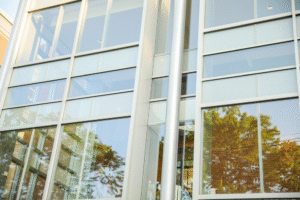
A stunning façade means little if your doors swell, warp, or leak after the first season. In high-demand environments, selecting the best materials for commercial windows and doors is a strategic move that impacts energy bills, tenant satisfaction, and the building’s long-term durability.
With so many options on the market, understanding how the materials perform under pressure, how they age, and how they affect energy models is critical. Aluminum, steel, fiberglass, treated wood, and PVC come with trade-offs that go beyond appearance or price tags.
This guide compares the best materials for commercial windows and doors side by side, breaking down durability, maintenance requirements, thermal efficiency, and long-term cost-effectiveness.
How the best materials for commercial windows and doors impact building performance
Opting for the best materials for commercial windows and doors is fundamental in defining the operational success of a commercial building. Every window and door becomes a critical performance factor in environments where foot traffic is constant, exposure to harsh weather is inevitable, and energy efficiency is under scrutiny.
When inappropriate materials are used, problems arise quickly. Doors can swell and jam due to humidity, frames may deteriorate when exposed to UV radiation or extreme temperature swings, and poor insulation leads to inconsistent interior climates, higher HVAC loads, and rising energy costs.
Maintenance demands increase, inspections become more complex, and the building’s ability to retain tenants or meet sustainability targets is compromised.
Selecting the best materials for commercial windows and doors from the outset strengthens the building’s overall performance.
High-quality windows and doors maintain thermal stability, enhance physical security, reduce maintenance cycles, and support energy certifications. These benefits influence the asset’s operational costs, tenant satisfaction, and long-term market value.
Each commercial project presents unique demands based on its purpose, occupancy patterns, and local climate. Understanding the technical properties of materials is essential for matching the product to the project’s performance requirements.
Evaluating factors such as thermal breaks, corrosion resistance, impact ratings, and maintenance profiles ensures that the building will perform reliably through years of service without unnecessary interventions.
The following sections present a practical comparison of commercial window and door materials to guide durable, efficient decision-making.
Best materials for commercial doors
Commercial doors must perform under pressure, resist environmental stress, and maintain functional integrity across years of heavy use. Selecting the appropriate material is critical to balancing performance, maintenance demands, and lifecycle costs.
Below, we explore the most used materials for commercial doors, outlining their strengths, challenges, and typical applications:
Aluminum
Aluminum doors are a standard in commercial construction due to their high strength-to-weight ratio and excellent corrosion resistance. They are ideal for storefronts, office buildings, and public facilities where durability and aesthetic flexibility are required.
- Advantages: Lightweight, corrosion-resistant, recyclable, available with thermal breaks for better insulation.
- Challenges: Can dent under high impact if not reinforced; thermal performance needs enhancement in extreme climates.
Steel
Steel doors are selected for projects demanding maximum security and durability. They are common in industrial facilities, schools, hospitals, and service entrances.
Advantages: Exceptional strength, high fire resistance, strong deterrent against forced entry.
Challenges: Susceptible to corrosion without proper finishing; heavier than other options, which may require reinforced framing.
Fiberglass
Fiberglass-reinforced plastic (FRP) doors offer a high-performance alternative for environments where hygiene, moisture resistance, and impact durability are priorities, such as healthcare, laboratories, and coastal properties.
Advantages: Highly resistant to moisture, chemicals, and physical abuse; low maintenance; excellent for hygienic environments.
Challenges: Higher initial cost compared to traditional materials; limited customization in some cases.
Solid treated wood
Treated wood doors are still used in commercial settings where visual impact is prioritized, such as boutique hotels, historic renovations, or high-end corporate offices.
Advantages: Superior aesthetic quality; natural thermal and acoustic insulation properties.
Challenges: Requires consistent maintenance to prevent warping, swelling, or decay; less impact-resistant than metal or fiberglass.
Reinforced PVC
In light commercial applications, reinforced PVC doors are used for areas where cost efficiency, basic thermal performance, and minimal maintenance are key, such as interior commercial spaces, light retail, and service corridors.
Advantages: Lightweight, corrosion-resistant, cost-effective, and low maintenance.
Challenges: Lower structural strength; unsuitable for high-security applications or exterior heavy-traffic zones.
Choosing the right material begins with understanding the specific demands of the space: expected traffic volumes, weather exposure, safety requirements, and long-term performance goals. Each material responds differently under operational pressures, and selecting each one appropriately prevents future inefficiencies and additional replacement costs.
In the next section, we’ll examine the materials most commonly used for commercial windows, with the same focus on technical performance and operational value.
Best materials for commercial windows

Windows in commercial buildings are critical components in energy management, occupant comfort, security, and long-term operational efficiency. Choosing the right window material is essential to ensuring the building performs as intended under real-world conditions.
Here’s a breakdown of the most commonly used materials for commercial windows:
Thermally broken aluminum
Thermally broken aluminum systems are a mainstay in modern commercial architecture, offering a balance between strength, design flexibility, and energy efficiency.
Advantages: High structural integrity; excellent design adaptability; corrosion resistance; thermal breaks minimize heat transfer and improve energy performance.
Challenges: Requires precise installation to maintain energy performance; unbroken aluminum frames can still conduct heat if improperly specified.
Double-glazed or triple-glazed units
Glazing configurations affect thermal insulation, acoustic performance, and energy costs. Double or triple-glazed windows are standard in high-performance commercial buildings.
Advantages: Significant reduction in heat loss and solar heat gain; improves interior acoustic control; supports energy code compliance.
Challenges: Higher initial cost compared to single glazing; increased frame requirements to support additional weight.
uPVC (Unplasticized Polyvinyl Chloride)
uPVC windows offer a cost-effective solution for commercial spaces that prioritize thermal performance and minimal maintenance over heavy structural demands.
Advantages: Strong thermal insulation properties; resistance to moisture and corrosion; low maintenance; lower upfront investment.
Challenges: Lower structural strength compared to metal frames; may degrade in color and rigidity under intense UV exposure if not UV-stabilized.
Composite metal systems
Composite window frames, combining aluminum with interior insulating cores or cladding, provide a high-performance alternative for demanding commercial applications.
Advantages: Strong structural stability; enhanced thermal efficiency through integrated insulation; environmental degradation resistance.
Challenges: Higher cost relative to standard aluminum systems; careful specification required to ensure compatibility with project performance goals.
Understanding the unnique strengths of the best materials for commercial windows and doors is key to selecting solutions that deliver consistent energy performance, meet security and safety standards, and maintain the building’s operational integrity over time.
In the next section, we’ll present a side-by-side practical comparison of these materials, helping you evaluate durability, energy efficiency, and maintenance demands.
Comparison of the best materials for commercial windows and doors
| Material | Energy efficiency | Durability and longevity | Maintenance demands |
| Aluminum | Good with thermal break technology; otherwise average | Long lifespan, enhanced with anodized or powder-coated finishes | Low; periodic inspections recommended |
| Steel | Moderate; depends on additional thermal treatments | Outstanding strength; vulnerable to corrosion if unprotected | Moderate to high; needs monitoring and refinishing |
| Fiberglass | Excellent; strong thermal stability | Exceptional resistance to moisture, impacts, and temperature shifts | Very low; minimal ongoing maintenance |
| Treated wood | Natural insulator; good thermal properties | Good in controlled environments; vulnerable to moisture | High – frequent sealing, painting, or staining needed |
| Reinforced PVC | Very good; naturally low thermal conductivity | Satisfactory in low-stress environments; UV exposure can affect durability | Low; mainly cleaning and visual inspections |
| Thermally broken aluminum | Strong; thermal breaks minimize conductive heat transfer | Long lifespan in varied climates | Low; maintenance similar to standard aluminum |
| Double/Triple Glazing | Excellent; critical for insulation and noise reduction | Dependent on seal integrity, very reliable with proper installation | Low to moderate; periodic checks on seals |
| uPVC | Excellent thermal insulation | Good lifespan; potential UV degradation if not stabilized | Low; very little required |
| Composite metal systems | High; combines structure and insulation | Long-lasting; resistant to environmental damage | Low; periodic cleaning and checks |
Choosing the best materials for commercial windows and doors requires balancing performance, functional demands, climate challenges, and budget constraints.
A strong material strategy minimizes unexpected costs, facilitates compliance, reduces downtime for repairs, and contributes to the building’s market appeal.
The next section will show how to apply these insights to select the best materials for commercial windows and doors based on your project’s specific demands.
How to choose the best materials for commercial windows and doors
Selecting the best materials for commercial windows and doors is a strategic decision aligned with project-specific demands.
A material that performs exceptionally well in a coastal environment may not be the best choice for a high-traffic downtown office.
Key factors to guide an informed material selection:
Building type and usage patterns
The building’s purpose influences material selection. High-traffic environments such as retail stores and schools demand materials with superior impact resistance and low maintenance needs. In contrast, corporate offices or healthcare facilities often prioritize energy efficiency, sound control, and clean aesthetics.
Local climate and environmental exposure
Climate conditions dictate much of the material performance over time.
- Humid or coastal areas require materials resistant to corrosion and moisture infiltration.
- Cold climates benefit from materials that offer strong thermal insulation to reduce heating loads.
- High-solar areas demand solutions that minimize solar heat gain without compromising interior comfort.
Choosing materials that naturally resist environmental stresses reduces maintenance costs and extends the installation’s lifespan..
Energy efficiency goals
Thermal performance becomes non-negotiable if the project is targeting LEED certification, ESG metrics, or long-term operational cost reductions. Materials with proven insulation capabilities, low U-Factor ratings, and high-performance glazing should be prioritized.
The best materials for commercial windows and doors should complement the building’s energy model, not work against it.
Security and code compliance
Certain commercial spaces require doors and windows with enhanced security standards and impact ratings. Local building codes may also mandate minimum energy efficiency, fire ratings, and structural performance which must be checked.
Maintenance capacity and lifecycle costs
A lower upfront price may lead to higher operational expenses due to repairs, replacements, and performance degradation. Prioritize the best materials for commercial windows and doors that balance initial investment with low-cost maintenance.
Checklist: Questions to guide your material selection
- What level of daily traffic and wear will the doors and windows face?
- What are the primary climate challenges at the project location?
- Is energy efficiency a priority for certifications, compliance, or operational savings?
- What security or impact standards must be met?
- What is the expected maintenance budget and frequency over 10–20 years?
- Does the material align with the project’s design intent?
Careful evaluation of these questions ensures that the best materials for commercial windows and doors will perform consistently, protect the investment, and support the building’s operational goals long after construction is complete.
In the next section, we’ll highlight common mistakes to avoid when selecting window and door materials so you can strengthen your project strategy even further.
Common mistakes when choosing materials for commercial windows and doors
Even experienced professionals can encounter costly setbacks when material selection doesn’t align with the operational realities of a commercial building.
Most issues arise from early-stage decisions based on incomplete evaluation or misplaced priorities.
Here are the most common mistakes to watch for and how to avoid them:
Prioritizing upfront cost over long-term performance
Choosing a material solely based on initial cost often leads to higher operational expenses later. Materials with lower upfront pricing may deteriorate faster, require more frequent maintenance, or fail to meet evolving energy standards.
Always weigh initial investment against lifecycle costs, including energy performance, maintenance cycles, and expected lifespan.
Overlooking climate-specific demands
Materials optimized for one region may underperform in another. Systems not designed for local humidity, temperature extremes, solar exposure, or coastal corrosion quickly become liabilities.
Match best materials for commercial windows and doors to environmental challenges, factoring in humidity resistance, UV stability, and thermal insulation as needed.
Underestimating maintenance requirements
Some materials require consistent upkeep to maintain performance and appearance. Deterioration accelerates, and costs rise if maintenance demands exceed the building’s operational capacity.
Select materials whose maintenance profiles align realistically with building management resources and tenant expectations.
Underestimating installation quality
Even the best materials for commercial windows and doors can fail if installed incorrectly. Improper sealing, poor anchoring, and failure to preserve thermal breaks compromise the entire system.
Work only with certified installers experienced in specific material and manufacturer guidelines to maintain performance ratings.
Overlooking long-term operational goals
Short-term project pressures can cause teams to overlook how material choices impact long-term building performance, tenant satisfaction, and future compliance requirements.
Specify materials that support the building’s five, ten, and twenty-year operational strategy, not just immediate project deadlines.
Avoiding these mistakes protects the entire project’s financial health, market positioning, and reputation.
Building smarter starts with choosing the best materials for commercial windows and doors

Material selection is a decision that defines how a building performs, how it ages, and how it supports the businesses and people who use it every day.
Throughout this guide, you’ve seen how the best materials for commercial windows and doors balance initial investment with long-term durability, energy efficiency, regulatory compliance, and operational cost control.
Choosing wisely prevents premature failures, reduces maintenance demands, and strengthens the building’s long-term value in the market.
Each project demands a solution aligned with its purpose, location, and performance goals. There is no universal answer, but there is a clear path when the right factors are considered from the start.
Whether designing, upgrading, or managing a commercial property, Top Notch Remodeling helps you specify and install the best materials for commercial windows and doors. Our team combines technical expertise with real-world project experience to ensure your building is protected, efficient, and built to last.
Contact us today to explore tailored solutions that match your project’s demands!



